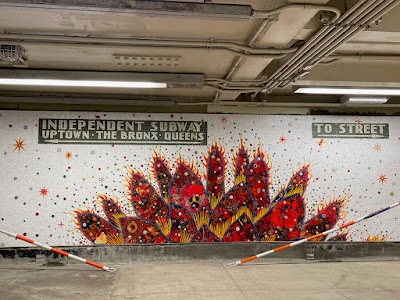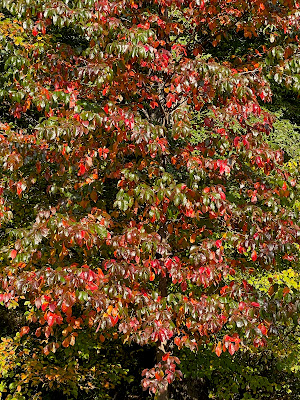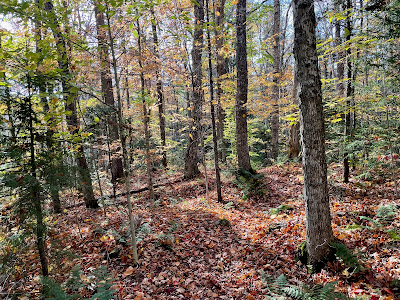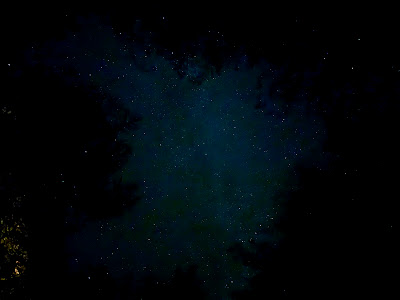 A little blast from the past, courtesy of Facebook: eleven years ago!
A little blast from the past, courtesy of Facebook: eleven years ago!
Thursday, October 31, 2024
Wednesday, October 30, 2024
Tuesday, October 29, 2024
Peak foliage
 Today they really let loose. From the 4th floor skybridge and looking down from my classroom on the 6th floor - what splendor!
Today they really let loose. From the 4th floor skybridge and looking down from my classroom on the 6th floor - what splendor!
Monday, October 28, 2024
Saturday, October 26, 2024
Rockland Lake
Thursday, October 24, 2024
Correlations
Behold the eye-popping view down on the Lang courtyard maples, through a gap in the window from my classroom on the 6th floor. I swooned Most of my pictures, like this one at left, are taken from the fourth floor. Since the leaves' undersides are pale, the deep red is diluted a bit. Down in the courtyard below, the light is golden but the flaming colors are visible only among the fallen leaves.
 But that was enough today to allow for a charmed conversation with a
Chinese student I'm doing an independent study with. (We're reading
around James' Varieties of Religious Experience, and have moved into David Yaden and Andrew Newberg's Varieties of Spiritual Experience which
- how to put it? - lacks James' existential urgency. More about that
another time (for me this is prep for one of my spring 2025 classes, a
course around James' Varieties).
But that was enough today to allow for a charmed conversation with a
Chinese student I'm doing an independent study with. (We're reading
around James' Varieties of Religious Experience, and have moved into David Yaden and Andrew Newberg's Varieties of Spiritual Experience which
- how to put it? - lacks James' existential urgency. More about that
another time (for me this is prep for one of my spring 2025 classes, a
course around James' Varieties).
After lamenting that the studies Yaden and Newberg synthesized offered at best correlations - areas of the brain or surveys that light up during particular kinds of reported or live experience, but what causes what? - we found ourselves talking about what they call the "circumstances" in which spiritual experiences seem more likely to arise. This is a useful complement to James, who rather too quickly privileges experience in "solitude." Contemplative practices, repetitive rituals, nature, etc. are discussed, but we wound up talking together about language, and why it's often said (sic!) that spiritual experiences are ineffable, beyond language. Don't you need a name or category for certain kinds of experience even to recognize what they are - even if that word is "ineffable"? or 道可道 非常道 名可名 非常名?
We were thinking of the subjects of Tonya Luhrmann's studies, who are attentive to the possibility that something in their own inner monologue - an attempted dialogue with God - didn't just come from themselves. If there are such things, knowing of their possibility - having names for them - would make all the difference. What other linguistic things might change people's experience - either make them aware of otherwise unrecognized realms of experience or make them think such realms exist? I suggested the habitual use by a whole society of a phrase like inshallah (God willing) could make a person aware of every juncture as potentially one in which the divine intervenes, make any event an occasion for gratitude.
But perhaps even more was given to those who knew more than one language (as James did, fluent in German and French), allowing them to experience everything as something linguistically modulated... My student was thinking Sapir-Whorff, and told me the English language makes him, he thinks, more open to spiritual experience (and God). Were there any realities Mandarin alone offered him awareness of, I asked? He mentioned count nouns (counters, classifiers), something which to a non-native seems pretty arbitrary, but he was thinking especially about the ways human lives are counted: 一百条命. That this was the same counter used for other long things, like ribbons, roads and rivers, made it seem obvious that lives were something of which one would have many.
Is English, which renders everything an object or a subject, better, as it insists on linear causality, I wondered? We considered western languages which gender all nouns, as English doesn't. Or pronouns English has shed, like the intimate thou (as in the inshallah-like "thy will be done"), not to mention the long lost dual (which Chinese has analogs, I think, in 俩 or even 咱们), or the middle voice. The student mentioned ki, the new pronoun Robin Wall Kimmerer proposed for living things, which made the whole space light up a little more. Spirit was flowing, though don't ask me to tell you what caused what! And kin were part of it all along, it seemed!
Mosaicity
 These are at the entrance to the northbound lines at 14th Street and Sixth Avenue. I'll check back to find out whose work they are... And there are almost certainly three more, on the southbound side!
These are at the entrance to the northbound lines at 14th Street and Sixth Avenue. I'll check back to find out whose work they are... And there are almost certainly three more, on the southbound side!
[It's Fred Tomaselli]
Tuesday, October 22, 2024
It never gets old
Time for my annual shpiel about New School history for the peer mentors of the first year class. It's different each time, even though I've used the same framework for several years - a poll of their first acquaintance with the school and what they know if its history, and then a peeling away of the parts of the school we now know, working through milestones in reverse chronological order so they can rebuild it in the sessions they lead with their students.
2015 - creation of the College of Performing Arts out of what had been autonomous schools of drama, music and jazz, each with its own unique past, a forced fusion which made real potentials for collaboration that had been only theoretical before
1985 - belated establishment of a four-year college for traditional age students, confirmation of how backwards-inside out our history has been
1970 - merger with Parsons School of Design, huge surprise to all concerned
1933 - University in Exile's rescue of many European scholars threatened by the rise of fascism and, as a condition for their visas, introduction of degrees (graduate!) to what had been a school firmly against them
1919 - new "school" (decisively not "university") cooked up by various reformers, mostly women, in the office of The New Republic
I suggested that for much of the history, leaders had to make seem coherent and planned what was really serendipity - our present moment no exception. There's no blueprint for how to do what we alone can do, given the characters we've assembled - certainly not the visions of our "founders," who could never have imagined what we've become. (So, I mentioned in an aside, resist arguing "The New School has from its founding been/was supposed to be...")
I suppose it might seem a bit disconcerting, all this contingency, but I think I managed to make it all seem quite exciting. A place on the make! I used to say "each student has to make their own university" but found myself not using the university language today. Instead the picture was of finding yourself with unexpected fellow travelers, whose proximity allows unprecedented collaborations and discoveries. It would have undermined my point to quote from the 1918 proposal but I will here: "a spiritual adventure of the utmost significance"!
Dead heat
May I say I am petrified thinking about the election in two weeks?
It's not just that the candidates are "neck and neck," and that the outcome will be determined by a tiny subset of the electorate who claim to be undecided in swing states - not by folks like me (although I am bombarded by messages, pleading and scolding and hysterical, telling me my $3 or $47 could save the Senate, the House, the nation in one race or other). The US has been split uncannily nearly fifty-fifty for as long as I can remember.
It's that one of the candidates is loco and it seems not to matter. I can't decide whether I think the bulk of those likely to vote for him are misinformed about him and his opponent, whether they know but think him the lesser evil, or whether they know exactly and, quietly or loudly, approve of the madness. The former is worrisome enough. What can one do in a media environment in which distortions, lies and conspiracies run rampant, egged on by foreign powers, malevolent billionnaires and cynical opportunists at every level? (The mainstream media has played its part, too, perhaps lulled by the rhythm of our fifty-fifty history to normalize a candidate and party which have declared war on the system.) Jill Lepore saw this fateful fracturing of a shared reality by new media already in These Truths in 2018.
But the even more frightening possibility is the latter, which a wider historical view suggests is eminently possible. They know what they're voting for: they want it! I keep thinking of what Karl Popper called the "paradox of democracy" - that a people could democratically end itself, knowingly vote in a tyrant. Usually I take for granted that, if everyone voted and things like the Elector College did not distort things, the good guys would win. The outcome I half expect, based on recent history, is a clear popular vote majority with swing state-caused uncertainty or worse at the level of electoral vote tally. But the possibility that large numbers of people have so lost faith in the system as to support the side promising to demolish it haunts me.
Monday, October 21, 2024
Cornucopia
Saturday, October 19, 2024
Thursday, October 17, 2024
Chop chop
After a bit of a hiatus, drawing is back in "Religion of Trees." Today's class was a working our way through representative chapters from Stephanie Kaza's wonderful Buddhist Conversations with Trees. (I might have time later to tell you how this provided the perfect text for approaching a more general first year seminar topic: how to read a book - and why.)
The last of the chapters I'd selected, "Cutting Wood," narrates her experience stacking and then cutting wood for her fire - with a chainsaw! Kaza's reflection is framed in terms of a koan: "What is my relationship with wood?" I was going to have us take time to write on this ourselves, but the clock ran out. Instead, I made the prompt for our drawing just "wood." Assorted relationships are examined and unexamined here. (The recursive one at top left is by yours truly.)
Monday, October 14, 2024
Ethically sourced
"Theorizing Religion" did the AMNH "Asian Peoples" galleries one better today. After we shared our generally very critical appraisals of the layout, contents and language of the gallery - indeed its very appearance in a museum of natural history! - I said: Suppose they said "We hear you. This exhibition is an embarrassment. We're taking it down. Give us some ideas for what we could do with that space to offer a better understanding of religion."
 Folding in what we had deemed most powerful about the less problematic Northwest Coast Hall as well as themes from our class discussions on what's excluded in definitions of "world religions" and even "religion," one group kept the architecture of the existing gallery but transformed it in a most marvelous way!
Folding in what we had deemed most powerful about the less problematic Northwest Coast Hall as well as themes from our class discussions on what's excluded in definitions of "world religions" and even "religion," one group kept the architecture of the existing gallery but transformed it in a most marvelous way!
Tree growth!
Sunday, October 13, 2024
Wednesday, October 09, 2024
Spectral tree
Checked out that London Plane with no northerly branches we learned from the New School Forest archive was "holding the memory of its dead neighbor." It is indeed without branches or branch scars on that side, testimony to the larger and older neighbor. And the neighbor's stump is indeed still there, just beyond the wrought iron fence, a little hard to make out beneath a bird bath in some shrubbery. From across the street you can almost sense the shape of the missing giant - a hole in the canopy of the New School forest!
Tuesday, October 08, 2024
Stumped by the Archives
This was a little disappointing, especially as I was having an epiphany of my own - and also one triggered by not finding what I was looking for. The archivists had brought out most of the tree-related items they'd offered me when I was assembling my "New School Trees" zine last year, including the large plan for a garden behind The New School's main building from September, 1950 (above). The archivist who was our host pointed out that the plan was by one "J. J. Levison M. F." which she presumed meant Master Forester. (It does.)
I'd wondered last year whether this garden had ever been built; if so it would have been a casualty of the 1956 extension which created the courtyard we now know. This time we had a likely way to find out: a folder of correspondence with J. J. Levison from 1948-1960. Progress on the garden would surely be documented here!
None was, so this was likely a proposal never enacted. (For what it's worth, though, the three "existing trees" marked in the plan were real.) But when the archives close a door they invariably open a window. From the correspondence folder it became clear that Jacob Joshua Levison was not only a Master Forester (trained at Yale) but the instructor of a beloved course which had been running at The New School since 1941.
There's correspondence about a 1951 iteration - maybe one longer field trip instead of three? - but the course seems not to have run again. The garden sketch was in effect a parting gift after a decade's teaching at The New School. The course was evidently fondly remembered, and in November, 1959, our long-time president Alvin Johnson said a few words when Levison received an award for City College alumni; the next day he penned a letter of thanks and appreciation, apologizing for not having said all he wished to:
You are a tree, Jack Levison. A tree is always beautiful, in its spring leafage and in its full summer foliage, in its autumn color and its bareness after frost, revealing the consummate design of its branching and the noble strength of its trunk.
The tree is the only living thing that keeps its beauty in old age; indeed reaches its highest beauty then. The tree, and some few mortals like Jack Levison.
Perhaps it was too much to expect these students, barely halfway through their second month of college, to delight in the way evidence can disconfirm our expectations and invite us to discover things we hadn't imagined! Into such gaps questions and research can grow!
 But perhaps one of the New School Forest cards I lingered over with them - 7 West 11th Street, next to the churchyard of First Presbyterian - may have left a trace, opened a space...
But perhaps one of the New School Forest cards I lingered over with them - 7 West 11th Street, next to the churchyard of First Presbyterian - may have left a trace, opened a space...
Amazing example of a L[ondon] P[lane] holding the memory of its dead neighbor, an oak in the churchyard that was cut down; no branches on north side because of the oak which is now a stump.
We'll go check on that tree when I see them next, and on its unforgotten neighbor.
Roundtable!
 Religious Studies Roundtables are back! Join us a week from today for a chance to hear the faculty teaching our courses in Hebrew Bible, Catholic Saints and Islam discuss their own exciting research!
Religious Studies Roundtables are back! Join us a week from today for a chance to hear the faculty teaching our courses in Hebrew Bible, Catholic Saints and Islam discuss their own exciting research!
Sunday, October 06, 2024
Saturday, October 05, 2024
Suddenly fall
If I wasn't ready for the leaves, I also wasn't ready for fall. Heading north in this season always fast-forwards the season in a jarring way, allowing a wanted or wanted sneak peak of what is to come, soon corrected when we head back, but this time I felt almost affronted. I wasn't ready for this! I didn't need (or deserve) a holiday yet - we're just six weeks into the semester. And the terrifying debacle of the election, surely it's not just a month away?! Eventually, though, the lyricism of the changing colors got to me.
The spectacle of fall foliage continues to confound me with feelings I can't parse - though I'm getting there! It's odd, as I remarked last year, for humans to trek out to these forests only to see the end of something, as though this were the goal, not the byproduct of winding up. But I've had the chance to spend more time with deciduous forests this year than ever before (though the fate of the forest I saw dance into spring in North Carolina is unclear...), including up here. With a few exceptions, every leaf I was seeing will have been new to me, new since last year.
Didn't Simon and Garfunkel sing about this?
Hello, hello, hello, hello
Good-bye, good-bye, good-bye, good-bye
That's all there is
And the leaves that are green turn to brown ...
But that's not quite what I'm feeling (though I wonder now about the residues left by hearing this song in my Southern California childhood!). I feel I know these trees a little better. Yes, these leaves are being released to their next mission, as have countless generations of leaves past. Their work is not done, or maybe their work but not their contribution. In a new piece, Robin Wall Kimmerer writes of fallen cedars but what she says applies to everything in the forest:
As inert as the logs seem, there is a ferment of activity inside, like dreams moving inside the head of a sleeper. … When the tree was alive, most all of the cells in the trunk of the tree were dead. They were just empty tubes designed to hold up the tree and to transport water. But now that the tree is dead, it is more alive than ever before.
The very soil beneath our feet is sublimed leaf litter. Since last fall I've got a deeper sense that the forest is a circle, nothing lost or squandered. We see only some of it, and value even less.
Tuesday, October 01, 2024
Natural history of religion

The absence of galleries on, um, white people is damning. (In fact it would be hard to find a better illustration of the things we've been reading about in Tomoko Masuzawa and Sylvia Wynter, the racialization of non-western cultures as "natural" phenomena whose pith is religion.) But Christianity sneaks in, in the little vitrine in the "Asian Peoples" gallery devoted to Georgians, a minority tradition barely worthy of description.


.jpeg)


.jpeg)

































